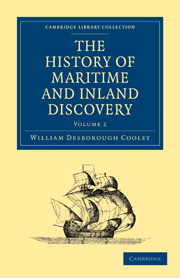Book contents
- Frontmatter
- Contents
- CHAP. I COLUMBUS
- CHAP. II COLUMBUS AND AMERIGO VESPUCCI
- CHAP. III EARLY DISCOVERIES IN AMERICA
- CHAP. IV SPANISH DISCOVERIES, AND FIRST CIRCUMNAVIGATION OF THE EARTH
- CHAP. V FERNANDO CORTEZ
- CHAP. VI CONQUEST OF PERU
- CHAP. VII CONQUESTS OF THE SPANIARDS
- CHAP. VIII CONQUESTS OF THE PORTUGUESE
- CHAP. IX FERDINAND MENDEZ PINTO
- CHAP. X VOYAGES TO THE NORTH
- CHAP. XI VOYAGES TO THE NORTH
- CHAP. XII VOYAGES TO THE NORTH
- CHAP. XIII SETTLEMENTS IN THE EAST
- CHAP. XIV SETTLEMENTS IN NORTH AMERICA
- CHAP. XV ESTABLISHMENTS IN AFRICA
- CHAP. XVI VOYAGES TO THE SOUTH SEA
- CHAP. XVII VOYAGES TO THE SOUTH SEA
- CHAP. XVIII VOYAGES IN THE PACIFIC, AND DISCOVERY OF AUSTRALIA
- CHAP. XIX EXPEDITIONS OF THE BUCCANEERS IN THE SOUTH SEAS
- CHAP. XX VOYAGES OF PRIVATEERS AND OTHERS TO THE SOUTH SEA
- CHAP. XXI DISCOVERIES OF THE RUSSIANS
- CHAP. XXII DISCOVERIES OF THE RUSSIANS
CHAP. XVIII - VOYAGES IN THE PACIFIC, AND DISCOVERY OF AUSTRALIA
Published online by Cambridge University Press: 05 October 2010
- Frontmatter
- Contents
- CHAP. I COLUMBUS
- CHAP. II COLUMBUS AND AMERIGO VESPUCCI
- CHAP. III EARLY DISCOVERIES IN AMERICA
- CHAP. IV SPANISH DISCOVERIES, AND FIRST CIRCUMNAVIGATION OF THE EARTH
- CHAP. V FERNANDO CORTEZ
- CHAP. VI CONQUEST OF PERU
- CHAP. VII CONQUESTS OF THE SPANIARDS
- CHAP. VIII CONQUESTS OF THE PORTUGUESE
- CHAP. IX FERDINAND MENDEZ PINTO
- CHAP. X VOYAGES TO THE NORTH
- CHAP. XI VOYAGES TO THE NORTH
- CHAP. XII VOYAGES TO THE NORTH
- CHAP. XIII SETTLEMENTS IN THE EAST
- CHAP. XIV SETTLEMENTS IN NORTH AMERICA
- CHAP. XV ESTABLISHMENTS IN AFRICA
- CHAP. XVI VOYAGES TO THE SOUTH SEA
- CHAP. XVII VOYAGES TO THE SOUTH SEA
- CHAP. XVIII VOYAGES IN THE PACIFIC, AND DISCOVERY OF AUSTRALIA
- CHAP. XIX EXPEDITIONS OF THE BUCCANEERS IN THE SOUTH SEAS
- CHAP. XX VOYAGES OF PRIVATEERS AND OTHERS TO THE SOUTH SEA
- CHAP. XXI DISCOVERIES OF THE RUSSIANS
- CHAP. XXII DISCOVERIES OF THE RUSSIANS
Summary
While the geography of South America thus rose into clear light, the obscurity of fable and uncertainty still hung over the northern portion of that great continent. When Cortereal returned from the coast of Labrador, where he had probably entered the Gulf of St. Lawrence, he reported that he had discovered the Straits of Anian, which were supposed at that time, and for ages afterwards, to conduct into the Pacific Ocean. The origin of this name is uncertain, but the belief in the existence of the Straits of Anian gave rise to many a fiction, and communicated a tinge of the fabulous even to voyages that were actually performed. But as men are more willing to believe in the activity of their imaginations, than in their liability to become its dupes, accounts which had so large a mixture of the incredible were looked upon as mere inventions, and wholly disregarded.
The celebrated voyager Andres de Urdaneta, who accompanied Legaspi on his expedition to the Philippines, and returned to New Spain by the northern Pacific, was reported to have discovered a northern strait conducting from the great ocean into the Atlantic. The high reputation of Urdaneta as a navigator and cosmographer, by representing him as a fit person to solve an interesting geographical problem, may have conduced, along with some speculations found among his papers at his death, to give rise to this report.
- Type
- Chapter
- Information
- The History of Maritime and Inland Discovery , pp. 279 - 298Publisher: Cambridge University PressPrint publication year: 2010First published in: 1830



